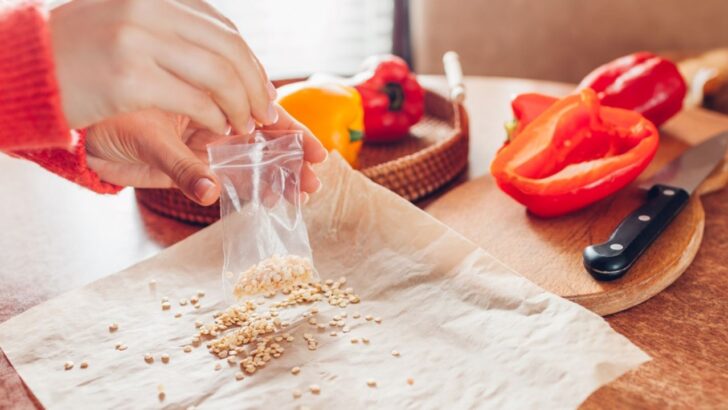Any gardener who’s ever opened a seed packet only to be ambushed by a mini-avalanche of rogue spinach and tomato seeds knows that seed saving is great—but seed organizing? That can be a whole other packet of misery.
Most people have their seeds in an old shoe box tucked not-so-neatly somewhere in the garage. A popular YouTube short by @Lauren shows us a better way. She casually pulls out a seed binder like it’s just another day in plant paradise.
You may be a rookie with big garden dreams or a seasoned grower with seed packets dating back to the Jurassic era. Regardless, it’s time to reach for your old-school binders. Let’s look at genius ways to store seeds.
1. Binders
The binder is the star of the show in genius seed storage. It’s cheap, neat, and most people already have one buried in a pile of forgotten school supplies.
Slide each packet into a sleeve, label it (herbs, veggies, flowers—whatever tickles your trowel), and you now have a Pinterest-worthy seed library. You can add a little silica gel pack (those “do not eat” packets) to absorb moisture. Seeds hate humidity more than slugs hate salt.
You can also certainly use the method with your own seeds you save from the previous year’s harvest.
2. Use Glass Jars
This one is for you if you love the look of mason jars and have a shelf that’s begging for a cottagecore moment. Just pop seed packets into jars and label them by type or planting season.
They stack beautifully and make any gardener look like they definitely own a greenhouse and compost religiously. Store the jars in a cool, dark place. Seeds are like introverts—they thrive when left alone in the dark for a while.
3. Try Altoid Tins
Mints aren’t the only thing these little tins are good for. Altoid containers are perfect for storing small batches of seeds, especially for gardeners who love swapping or gifting seeds to friends.
Just line the inside with wax paper or tiny envelopes, label the top, and you now have portable seed swag.
4. Organize with Photo Boxes
Those plastic photo storage boxes from the craft store are absolute gold for anyone with a growing seed stash. Each compartment can be used for a different crop, variety, or season. Plus, they stack beautifully and tuck away easily on a shelf.
Label the outside of each mini box and include planting notes inside—because “what variety of tomato was this again?” should not be an April mantra.
5. Use Envelopes and a Recipe Box
For a more classic, analog approach, small envelopes and a wooden recipe box are a winning combo. You might love this if you enjoy the ritual of sorting through seeds before each season.
You can add dividers for vegetables, herbs, flowers, or by planting month.

Image Credit: Shutterstock.
Rules for Seed Storage
Most seeds are like little sleeping dragons—full of power but fussy about where they nap. If you store them wrong, you may be met by sulky seeds on planting day. Store them right, and they burst to life when you need them most.
Follow these golden rules to keep your seed stash fresh, fierce, and ready to grow.
1. Keep Seeds Cool and Dry
The writing on the packet says to keep your seeds in cool, dry conditions isn’t just a suggestion, it’s their life-line. Store your seeds in a place that’s not too warm or humid (like a closet or a drawer), and avoid spots that get direct sunlight.
Heat and moisture can decrease seed viability and lead to mold or premature sprouting.
2. Seal in Airtight Containers
Air can be the enemy of seeds. Use airtight containers to protect them from moisture and pests. This helps extend their lifespan and keeps them ready to germinate when you’re ready to plant.
3. Label
Proper labeling and organizing make it easier to find seeds when planting season arrives. Regardless of what you use, each packet or container should be labeled with the plant type and date of purchase or harvest.
This keeps things tidy and prevents confusion when you plant basil only to find watermelons growing.
Helping Gardeners Feel Organized
When it comes to gardening, how you store your seeds makes a big difference. A binder might not look like much, but it can save you from mid-spring chaos and lost tomato dreams. The method you choose depends on what you have at hand—and how long you plan to store those seeds.
Some seeds (like lettuce and onions) have a shorter shelf life—about a year or two—while others, like tomatoes, can stay viable for 4 to 5 years if stored properly. And did you know ancient seeds have been found sprouting after centuries in dry, dark conditions?

